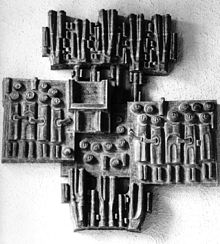Albrecht Glenz

Albrecht Glenz (born August 6, 1907 in Erbach im Odenwald ; † February 6, 1990 in Hanau ) worked as a sculptor in Frankfurt am Main , Erbach in the Odenwald and in Hanau and as an artistic lecturer in Erbach in the Odenwald and at the State Drawing Academy in Hanau active.
family
Albrecht Glenz came as the son of the ivory sculptor Otto Glenz and his wife Minna, nee. Arrass, to the world. From 1912 to 1916 he attended elementary school in Hanau, then went to high school in Michelstadt until he graduated from high school in 1925 and worked in his father's workshop. He was friends with the artist Reinhold Ewald . In 1935 he married Hildegard Müller, who died the following year after the birth of their daughter Gisela. In 1940 he married Ellen Strenger for the second time. Her son Christoph was born in 1940, the daughter Susanne in 1947 (today: Voss and also an artist).
Artistic career
In 1925/26 he attended the technical school for wood and ivory in Erbach, 1926/27 studied at the Munich Art Academy with Joseph Wackerle and from 1927–1932 at the Düsseldorf Art Academy as a master student of R. Richard Langer . Albrecht Glenz describes the influence of August Gaul on his early work as extremely important. In 1932 a six-month study visit to Paris and Spain followed. From 1932 to 1940 he worked as a freelance sculptor in Frankfurt am Main in a studio at the Städelschule . Here he created portrait busts of Leo Frobenius and Stefan George, among others . During this time he also worked continuously on the renovation of Frankfurt's old town . Most of the works created in the process perished with the destruction of Frankfurt in the Second World War , as did the entire inventory of works of art that were still in his studio. In addition, during his time in Frankfurt he made reliefs to design the Platz der Nation in Worms (today: Platz der Partnerschaft ). These are still preserved.
At the end of 1940 Albrecht Glenz was drafted into the Wehrmacht and was then taken as a prisoner of war by the United States . In 1946 he returned to Erbach, where his family had taken shelter during the war. In the same year he became a member of the Darmstadt Secession . In the following year he became director of the technical school for wood and ivory. At the same time he remained freelance. A number of sculptures were created in Frankfurt am Main: the figure of a mail rider for the Hainer Hof , in 1953 a “floating genius with the coat of arms of the city of Frankfurt” for the Bundesbahn headquarters and in 1960 a concrete relief on the New Nikolaikirche .
After dissolution of the college in 1955 Erbach Albrecht Glenz was as a lecturer moved to the drawing academy in Hanau, where his father had taught from 1912 to 1916. In addition to the works already mentioned for Frankfurt, others were created in public space. The altar cross and the candlesticks for the Christ Church in Hanau, the furnishings of the Luther Church in Hanau-Wolfgang with altar , baptismal font , pulpit and candlestick, a large sculpture for the jury court room in the district court of Hanau (today in the district court of Idstein ), a copper relief as a wall design in the Hanau employment office and a folding altar for the Stephanus Church in Göttingen .
From 1970 he worked as a freelance sculptor again and an extensive late work was created. The following are to be emphasized here: The bronze sculpture for the fairy tale “ The six swans and their sister ” for the corner situation at Freiheitsplatz / Hammerstraße in Hanau, today in the castle garden and the city meadow column in Erbach.
plant
Albrecht Glenz's work includes sculptural works in ivory , wood, bronze , copper and stone, including large sculptures. His style was a moderate realism, always linked to the natural model, but formally shortened to the point of abstraction. In addition to the sculptural work, there is also a very extensive graphic work.
His works are in the Hessisches Landesmuseum Darmstadt , the German Ivory Museum in Erbach, the Hanau Historical Museum and the Seligenstadt Landscape Museum .
Appreciations
- 1963: Honorary plaque of the Hessian Prime Minister in silver for his ivory work.
- In 1982, on his 75th birthday, he was awarded the August Gaul plaque from the city of Hanau.
- In 1993 the Hanau Historical Museum organized a comprehensive retrospective exhibition.
literature
- Anton Merk: Albrecht Glenz - Life and Work . In: City of Hanau: Albrecht Glenz 1907–1990 . Hanau 1993, pp. 4-7.
- City of Hanau (ed.): Albrecht Glenz 1907–1990 . [Exhibition catalog] Hanau 1993.
- Alexander Bastek (arr.): Of heads and bodies. Frankfurt sculpture from the Städel , Frankfurt a. M .: Städel 2006, ISBN 9783935283113 , pp. 244–245.
Individual evidence
- ↑ Merk, p. 5.
- ↑ The work of art has been lost since the Bundesbahn's head office was demolished.
- ↑ Catalog raisonné in: City of Hanau: Albrecht Glenz 1907–1990 . Hanau 1993, p. 10f.
| personal data | |
|---|---|
| SURNAME | Glenz, Albrecht |
| BRIEF DESCRIPTION | German sculptor |
| DATE OF BIRTH | August 6, 1907 |
| PLACE OF BIRTH | Erbach (Odenwald) |
| DATE OF DEATH | February 6, 1990 |
| Place of death | Hanau |


